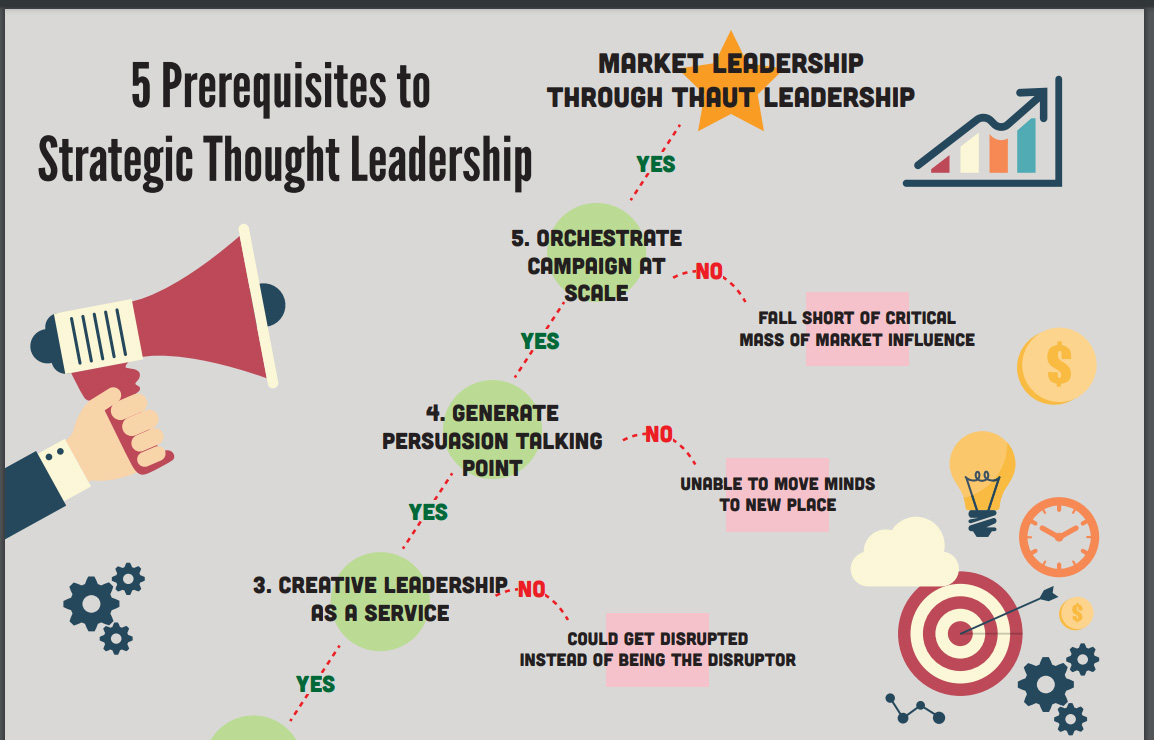Thought Leadership Studio Blog Posts:
Infographic - 5 Prerequisites to Strategic Thought Leadership
You need all of these to succeed with Strategic Thought Leadership. Consider them a series of traffic lights to your Thought Leadership destination.

#contentmarketing, #entrepreneurship, #infographics, #insight, #leadership, #marketing, #marketingresearch, #marketingstrategy, #persuasion, #strategicthoughtleadership, #systemsthinking, #thoughtleadership, #thoughtleadershipmodel, #workshop
Click here to jump to infographic.5 Prerequisites to Strategic Thought Leadership
The five prerequisites to successful strategic thought leadership are:
- Take the Audience's Point of View.
- Understand High Level Audience Thinking.
- Practice Creative Leadership as a Service.
- Generate Persuasive Talking Points.
- Orchestrate Your Campaign at Scale.
1. Take the Audience's Point of View.
For many, the starting point of Strategic Thought Leadership is a shift in perspective from how to sell them to how to serve them. This is the outside-in perspective, as contrasted to the more typical, Big Data top down perspective of seeing prospects as numbers to target. As per this Chart of how to Shift the Focus from Data Targeting to Audience Listening, we are:
- Responding to the pull of prospects' online research instead of pushing with interruption ads.
- Serving and leading the prospect instead of targeting them.
- Expecting they will grow to new learning rather than expecting them to repeat the patterns that enable predictive targeting.
Taking the customers point of view also makes it respect-based marketing.
Potential Shortfall #1: Lose market rapport by making it "all about us" or too self-serving to attract and build an audience.
2. Understand High Level Audience Thinking.
 Building on the core value of respect for the end customer, Strategic Thought Leadership relies more on Insight than just Information. The Thaut Process 7 Levels of Learning and Influence model helps point the way towards helpful insight into high-level audience thinking. These levels include:
Building on the core value of respect for the end customer, Strategic Thought Leadership relies more on Insight than just Information. The Thaut Process 7 Levels of Learning and Influence model helps point the way towards helpful insight into high-level audience thinking. These levels include:
- Skillset
- Mental Models (AKA Beliefs)
- Values
- Identity
- Core Purpose
Usually, thought leaders aim to help their followers grow in their knowledge or skills: expanding their Skillset. In this case, chunking down the knowledge or skills into bite-size pieces helps make each step feel doable.
Yet, there are higher and more impactful levels you can either:
- Align with, or
- influence.
These include discovering Higher Values in your audience to align with and strengthen by leading them to new, better Mental Models.
Put more simply, it means understanding what’s important to your followers that the conventional viewpoint doesn’t fulfill. This can concern where your product or service fits in their lives, what skills are important in a professional in your field, what the most important aspects of a service program are, or how to best use a product.
Potential Shortfall #2: Mismatch audience values so you are not resonating with what is important with them. Fail to clearly understand their current perspective on your product, service, field or profession.
3. Practice Creative Leadership as a Service.
Strategic Thought Leadership implies creatively designing a new perspective with new talking points in order to help your audience get more of what's important to them.
Hence the CLaaS acronym: Creative Leadership as a Service.
That's a tall order well beyond the scope of this post and infographic. Fortunately, you can search #creativity in blogs and podcast episodes for resources and ideas for tapping into your creativity for thought leadership.
And it is a necessity. Thought Leadership implies leading to the new. The new implies creativity.
Potential Shortfall #3: Miss the opportunity for a positive, yet disruptive Thought Leadership Position and get disrupted yourself instead. Or, fail to gather enough attention with the novelty and helpfulness of a truly new way of thinking about your field, profession, or business category.
4. Generate Persuasive Talking Points.
 Once you have designed a clear Thought Leadership Position, the next step is creating a set of persuasive talking points that:
Once you have designed a clear Thought Leadership Position, the next step is creating a set of persuasive talking points that:
- Undermines the old point of view.
- Supports the new point of view of your Thought Leadership Position.
NLP (Neuro-Linguistic Programming) offers multiple language patterns that influence on both a conscious and unconscious level. These patterns expedite the formulation of a Position Paper laying out a clear bridge between old thinking and new thinking. They form an essential part of the Thaut Process of Strategic Thought Leadership.
The resulting Position Paper can serve as the basis for a powerful content marketing, advertising, or public relations campaign.
Potential Shortfall #4: Fail to take the need to create a robust Thought Leadership Position, well-supported by persuasive talking points, seriously enough. Fall short of the degree of persuasion needed to truly move minds.
5. Orchestrate Your Campaign at Scale.
At this point, the game becomes translating your talking points into media, including any or all of these:
- Blog posts.
- Website content.
- Podcast episodes, whether your own or as a guest on others'.
- Video content, like a YouTube channel.
- A book.
- eBooks.
- Email newsletter.
Once you create Strategic Thought Leadership media, then you need to adequately promote it as well.
Obviously, the reach (how many people) and frequency (how much repetition of the message) need to be at an appropriate scale to meet the challenge.
It helps to define your influence goal. How would you define success?
Is there a certain size of community, audience, or market niche that buys into your Thought Leadership Position you are aiming for?
Are you looking to disrupt a large industry or simply build a small but loyal following?
Potential Shortfall #5: Fall short of the audience reach or frequency of your message needed to gain the level of impact needed. It does take enough scale and persistence.
The Traffic Light Model
 Some marketers will simply start at #5 and aim to reach a certain number of people often enough with a non-refined message. But, the impact won't be there without the prior prerequisites met.
Some marketers will simply start at #5 and aim to reach a certain number of people often enough with a non-refined message. But, the impact won't be there without the prior prerequisites met.
Consider them like a series of traffic lights. If a leader hasn't taken the audience's point of view, they are stuck at the "prerequisite #1" red light so can't approach the next light of "prerequisite #2" (understanding high-level audience thinking), let alone the rest.
Only by creating a "green light" condition at all 5 can you get to your destination of mass positive influence through Strategic Thought Leadership.
It isn't about hunkering down and gritting your teeth with high effort. Rather, it is more about orchestrating multiple factors concurrently for fluid success in a state of flow. Then the rewards and exhilaration of leading an audience to a new place are yours.
********
Enough said, here's your infographic! Feel free to do with it as you wish so long as you do not edit it in any manner.
Read online or download
***************************************